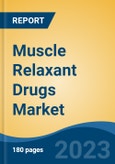Free Webex Call
The Muscle Relaxant Drugs Market was valued at USD 3.85 Billion in 2024, and is expected to reach USD 5.00 Billion by 2030, rising at a CAGR of 4.40%. The Global Muscle Relaxant Drugs Market constitutes a vital segment of the pharmaceutical industry, encompassing the research, development, production, distribution, and commercialization of medications designed to relieve muscle spasms, stiffness, and involuntary contractions. These drugs operate by targeting neurological pathways, either directly affecting the central nervous system (CNS) or modulating peripheral nerve activity, thereby promoting muscle relaxation. They are extensively prescribed for treating muscle strains, sprains, chronic back pain, fibromyalgia, multiple sclerosis, and spasticity associated with neurological conditions. Speak directly to the analyst to clarify any post sales queries you may have.
10% Free customizationThis report comes with 10% free customization, enabling you to add data that meets your specific business needs.
The market is undergoing rapid expansion, primarily fueled by the rising incidence of musculoskeletal disorders, an aging global population, and advancements in pharmaceutical formulations. The increasing prevalence of chronic pain and mobility-related conditions has intensified the demand for effective, well-tolerated muscle relaxants. Additionally, demographic trends particularly the growing proportion of elderly individuals have further propelled market growth, as older adults are more susceptible to arthritis, osteoporosis, and lower back pain, all of which necessitate muscle relaxant therapy.
Key Market Drivers
Rising Prevalence of Musculoskeletal Disorders
The increasing prevalence of musculoskeletal disorders (MSDs) is a major driving force behind the expansion of the Global Muscle Relaxant Drugs Market. MSDs encompass a wide range of conditions affecting the bones, muscles, ligaments, tendons, and joints, leading to chronic pain, reduced mobility, and functional impairments. The incidence of MSDs has risen sharply due to aging populations, sedentary lifestyles, workplace injuries, and increasing rates of obesity.According to the World Health Organization (WHO), an estimated 1.71 billion people worldwide are affected by musculoskeletal disorders, including lower back pain, neck pain, osteoarthritis, and rheumatoid arthritis. These conditions represent a significant global burden, driving the demand for effective treatment solutions within the pharmaceutical and healthcare industries, making them the leading cause of disability. Chronic conditions such as arthritis, lower back pain, and fibromyalgia have significantly increased the need for muscle relaxants to manage pain and improve quality of life.
Key Market Challenges
Competition from Generic Drugs
As patents for certain muscle relaxant drugs expire, the market faces increased competition from generic drug manufacturers. This competition can lead to price erosion and reduced profit margins for original drug developers. Pharmaceutical companies must navigate this challenge by differentiating their products through innovation, improved formulations, and enhanced therapeutic outcomes.Key Market Trends
Biologics and Novel Therapies
The emergence of biologics and novel therapies is reshaping the treatment landscape. Biologics, which are derived from living organisms, offer the potential for targeted interventions with fewer side effects. As research into biologics and advanced therapies progresses, new avenues for addressing musculoskeletal disorders may emerge, providing patients with innovative treatment options.Key Market Players
Amneal Pharmaceuticals LLC
Ipsen Biopharmaceuticals Inc
Merz Pharmaceuticals LLC
Par Pharmaceutical Inc
Endo Pharmaceuticals Inc
Vertical Pharmaceuticals Inc
Mallinckrodt LLC
Sterix Ltd
Eisai Co Ltd
Teva Pharmaceuticals USA Inc
Report Scope:
In this report, the Global Muscle Relaxant Drugs Market has been segmented into the following categories, in addition to the industry trends which have also been detailed below:Muscle Relaxant Drugs Market, By Drug Type:
- Skeletal Muscle Relaxant Drugs
- Facial Muscle Relaxant Drugs
- Neuromuscular Blocking Agents
Muscle Relaxant Drugs Market, By Route of Administration:
- Oral
- Injectable
- Others
Muscle Relaxant Drugs Market, By Distribution Channel:
- Hospital Pharmacies
- Retail Pharmacies
- Online Pharmacies
Muscle Relaxant Drugs Market, By region:
- North America
- United States
- Mexico
- Canada
- Europe
- France
- Germany
- United Kingdom
- Italy
- Spain
- Asia-Pacific
- China
- India
- South Korea
- Japan
- Australia
- South America
- Brazil
- Argentina
- Colombia
- Middle East & Africa
- South Africa
- Saudi Arabia
- UAE
Competitive Landscape
Company Profiles: Detailed analysis of the major companies present in the Global Muscle Relaxant Drugs Market.Available Customizations:
With the given market data, the publisher offers customizations according to a company's specific needs. The following customization options are available for the report.Company Information
Detailed analysis and profiling of additional market players (up to five).This product will be delivered within 1-3 business days.
Table of Contents
1. Product Overview
2. Research Methodology
3. Executive Summary
5. Muscle Relaxant Drugs Market Outlook
6. North America Muscle Relaxant Drugs Market Outlook
7. Europe Muscle Relaxant Drugs Market Outlook
8. Asia-Pacific Muscle Relaxant Drugs Market Outlook
9. South America Muscle Relaxant Drugs Market Outlook
10. Middle East and Africa Muscle Relaxant Drugs Market Outlook
11. Market Dynamics
12. Market Trends & Developments
14. Competitive Landscape
Companies Mentioned
- Amneal Pharmaceuticals LLC
- Ipsen Biopharmaceuticals Inc
- Merz Pharmaceuticals LLC
- Par Pharmaceutical Inc
- Endo Pharmaceuticals Inc
- Vertical Pharmaceuticals Inc
- Mallinckrodt LLC
- Sterix Ltd
- Eisai Co Ltd
- Teva Pharmaceuticals USA Inc
Table Information
| Report Attribute | Details |
|---|---|
| No. of Pages | 185 |
| Published | March 2025 |
| Forecast Period | 2024 - 2030 |
| Estimated Market Value ( USD | $ 3.85 Billion |
| Forecasted Market Value ( USD | $ 5 Billion |
| Compound Annual Growth Rate | 4.4% |
| Regions Covered | Global |
| No. of Companies Mentioned | 10 |









